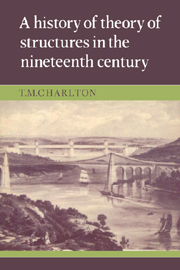Book contents
- Frontmatter
- Contents
- Preface
- 1 Introduction
- 2 Beam systems
- 3 Theory of the arch and suspension bridge
- 4 Elementary theory of frameworks: graphical statics
- 5 Theory of statically-indeterminate frameworks: the reciprocal theorem
- 6 Levy's theory of frameworks and bridge girders
- 7 Early developments of energy principles relating to theory of structures
- 8 The later development and use of energy principles
- 9 Applications of the least work principle: elastic theory of suspension bridges
- 10 Aspects of the further development of theory of structures
- 11 Secondary effects in structures
- Appendices
- Bibliography
- Name index
- Subject index
10 - Aspects of the further development of theory of structures
Published online by Cambridge University Press: 18 September 2009
- Frontmatter
- Contents
- Preface
- 1 Introduction
- 2 Beam systems
- 3 Theory of the arch and suspension bridge
- 4 Elementary theory of frameworks: graphical statics
- 5 Theory of statically-indeterminate frameworks: the reciprocal theorem
- 6 Levy's theory of frameworks and bridge girders
- 7 Early developments of energy principles relating to theory of structures
- 8 The later development and use of energy principles
- 9 Applications of the least work principle: elastic theory of suspension bridges
- 10 Aspects of the further development of theory of structures
- 11 Secondary effects in structures
- Appendices
- Bibliography
- Name index
- Subject index
Summary
After the theory of statically-indeterminate frameworks was established in Europe c. 1875, theory of structures advanced rapidly, especially by virtue of the property of a linear relationship between ‘cause’ and ‘effect’, which characterised engineering structures and which afforded the principle of superposition (Chapter 3) and the reciprocal theorem (Chapter 5). Dominant among the contributors to these advances were Mohr and Müller-Breslau in Germany, and much of this chapter is concerned with them and their work. Also, the Italian railway engineer, Crotti, deserves special mention for his unique contribution to the development of a general theory of elastic structures.
Mohr and Müller-Breslau
Mohr, born in 1835, was some sixteen years older than Müller-Breslau but nevertheless there seems to have been antagonism and rivalry between them, to judge, especially, from published comment by the latter, which is illuminating in various respects and is therefore included in this chapter. Müller-Breslau died in 1925, only seven years after Mohr. His later work was arranged for publication by his son who was a professor at the Breslau Polytechnikum. The final edition of part of his monumental work Graphische Statik der Baukonstruktionen anticipated important developments in theory of structures in the present century.
At the age of thirty-three, Mohr became professor of engineering mechanics at Stuttgart, having spent the early years of his career in railway construction in common with many distinguished civil engineers of the nineteenth century.
- Type
- Chapter
- Information
- A History of the Theory of Structures in the Nineteenth Century , pp. 140 - 156Publisher: Cambridge University PressPrint publication year: 1982

